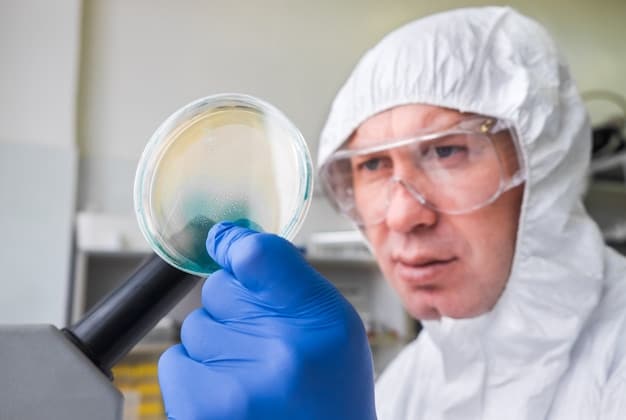EPA 2025 Regulations: Impact on US Manufacturers & Industrial Waste

EPA’s 2025 regulations on industrial waste are poised to significantly impact US manufacturers, necessitating re-evaluation and innovation in waste management practices to comply with stricter environmental standards and mitigate potential economic consequences.
How will the EPA’s new 2025 regulations on industrial waste affect American manufacturers? The landscape of industrial production is about to change, with potentially profound implications for companies across the United States. Let’s delve into what these regulations entail and how businesses can prepare.
Understanding the EPA’s 2025 Industrial Waste Regulations
The Environmental Protection Agency (EPA) periodically updates its regulations to better protect human health and the environment. The 2025 regulations on industrial waste represent a significant step forward in this ongoing effort. These rules aim to address the ever-increasing amounts of industrial waste generated and its potential impacts on ecosystems and communities.
These new regulations are not just about imposing restrictions; they’re about fostering a culture of responsible waste management and promoting sustainable practices within the manufacturing sector. Companies will need to understand the specific requirements and adapt their operations accordingly.
Key Changes in the 2025 Regulations
So, what exactly has changed? Several key areas have been updated or introduced:
- Stricter Limits on Pollutants: Expect lower allowable levels of specific pollutants in industrial wastewater and air emissions.
- Expanded Definition of “Industrial Waste”: The regulations may cover a broader range of materials and byproducts previously not classified as waste.
- Increased Monitoring and Reporting Requirements: Companies will likely need to implement more rigorous monitoring systems and submit more detailed reports to the EPA.
- Emphasis on Waste Minimization and Recycling: The EPA is encouraging manufacturers to reduce waste generation at the source and increase recycling efforts.
These changes will require manufacturers to invest in new technologies, processes, and training to ensure compliance. Proactive planning and adaptation are essential for minimizing disruption and maintaining competitiveness.

The Impact on US Manufacturers
The impact of the EPA’s new regulations will vary depending on the specific industry and the size of the manufacturing operation. However, some common challenges and opportunities will likely emerge for many US manufacturers.
Companies that fail to prepare adequately risk facing penalties, legal challenges, and damage to their reputation. On the other hand, those that embrace these changes can gain a competitive advantage by demonstrating environmental responsibility and attracting environmentally conscious customers.
Potential Challenges for Manufacturers
Here are some of the challenges that manufacturers may encounter:
- Increased Compliance Costs: Implementing new technologies, monitoring systems, and training programs can be expensive.
- Operational Disruptions: Changes to production processes and waste management practices may lead to temporary disruptions.
- Potential for Litigation: Non-compliance can result in lawsuits from the EPA and environmental groups.
Opportunity for Improvement
Overcoming these challenges will require strategic investments and a commitment to sustainability.
However, these challenges also present opportunities for innovation and growth. Manufacturers can develop new products and processes that generate less waste, utilize recycled materials, and reduce their environmental footprint.
By embracing sustainable practices, manufacturers can not only comply with regulations but also enhance their brand image, attract environmentally conscious customers, and gain a competitive advantage in the marketplace.
In conclusion, manufacturers must proactively assess their current waste management practices, identify areas for improvement, and develop strategies to comply with the new regulations while minimizing costs and maximizing opportunities for innovation.
Strategies for Compliance and Adaptation
How can US manufacturers effectively navigate these new regulations? A proactive and strategic approach is key to ensuring compliance, minimizing costs, and maximizing opportunities for innovation.
The key to success lies in embracing a holistic approach to waste management that encompasses everything from waste reduction and recycling to employee training and technology upgrades. Consulting with environmental experts and participating in industry collaborations can also provide valuable insights and guidance.
Conducting a Comprehensive Waste Assessment
The first step is to conduct a thorough assessment of current waste generation and management practices. This involves identifying the types and quantities of waste produced, evaluating current disposal methods, and assessing compliance with existing regulations.
This assessment should also include an examination of production processes to identify opportunities for waste reduction and optimization.
Investing in New Technologies and Processes
Many innovative technologies and processes can help manufacturers reduce waste, improve recycling rates, and minimize pollution.
- Advanced Wastewater Treatment Systems: These systems can remove pollutants from industrial wastewater more effectively than traditional methods.
- Closed-Loop Recycling Systems: These systems recycle waste materials back into the production process, reducing the need for virgin resources.
- Automation and Optimization Software: This software can help manufacturers optimize production processes to minimize waste generation.
In summary, by conducting a comprehensive waste assessment, investing in new technologies and processes, and prioritizing employee training, manufacturers can effectively comply with the new regulations while improving their environmental performance and competitiveness.

The Role of Technology in Compliance
Technology will play a crucial role in helping manufacturers meet the new EPA regulations. From advanced monitoring systems to innovative waste treatment technologies, the right tools can make compliance more efficient and cost-effective.
Manufacturers should explore the various technological solutions available and invest in those that best meet their specific needs and challenges.
Real-Time Monitoring and Data Analytics
Real-time monitoring systems can provide manufacturers with valuable data on waste generation, emissions, and resource consumption. This data can be used to identify areas for improvement, track progress toward compliance goals, and detect potential problems before they escalate.
Advanced Waste Treatment Technologies
New waste treatment technologies are emerging that can remove pollutants from industrial waste more effectively and efficiently than traditional methods. These technologies include membrane filtration, advanced oxidation processes, and biological treatment systems.
These solutions create a more sustainable and compliant manufacturing environment.
Collaboration and Partnerships
Navigating the complexities of the new EPA regulations can be challenging, especially for small and medium-sized manufacturers. Collaboration and partnerships can provide valuable resources, expertise, and support.
By working together, manufacturers can share best practices, develop innovative solutions, and advocate for policies that support a sustainable manufacturing sector.
Industry Associations and Trade Groups
Industry associations and trade groups can provide valuable information, training, and networking opportunities for manufacturers. These organizations often host workshops, seminars, and conferences on environmental compliance and sustainable manufacturing practices.
Joining an industry association can also give manufacturers a voice in shaping environmental policy and regulations.
Government Agencies and NGOs
Government agencies like the EPA and state environmental agencies can provide technical assistance and funding opportunities for manufacturers seeking to comply with environmental regulations. Non-governmental organizations (NGOs) can also offer valuable expertise and support.
By partnering with these organizations, manufacturers can access the resources and expertise they need to achieve environmental compliance and improve their sustainability performance.
In conclusion, a collaborative approach, involving industry associations, government agencies, and NGOs, can help manufacturers navigate the challenges of the new EPA regulations and build a more sustainable and competitive manufacturing sector.
Long-Term Sustainability and Competitiveness
The EPA’s new regulations present both challenges and opportunities for US manufacturers. While compliance will require investments and adjustments, it also paves the way for a more sustainable and competitive manufacturing sector.
Manufacturers that embrace innovation, collaboration, and a commitment to environmental stewardship will be best positioned to thrive in the long run.
Building a Sustainable Manufacturing Culture
Creating a sustainable manufacturing culture involves incorporating environmental considerations into all aspects of the business, from product design and production to waste management and supply chain management.
- Prioritize Resource Efficiency: Reduce the use of raw materials, energy, and water in production processes.
- Embrace Circular Economy Principles: Design products that can be easily recycled or reused.
- Engage Employees in Sustainability Efforts: Empower employees to identify and implement sustainability improvements.
Gaining a Competitive Advantage
Manufacturers that demonstrate a commitment to sustainability can gain a competitive advantage in several ways.
Embracing long-term sustainability allows manufacturers to not only comply with regulations but also enhance their brand image, attract environmentally conscious customers, and gain a competitive advantage in the marketplace.
| Key Point | Brief Description |
|---|---|
| ✅ Compliance | Adhering to EPA’s updated 2025 regulations. |
| ♻️ Sustainability | Promoting sustainable practices in manufacturing. |
| 💰 Cost Impact | Analyzing financial implications and cost-saving strategies. |
| 🔬 Technology | Implementing advanced technologies for waste reduction. |
Frequently Asked Questions (FAQ)
▼
The main goal is to reduce industrial waste and its environmental impact by setting stricter limits on pollutants, expanding the definition of industrial waste, and increasing monitoring and reporting requirements.
▼
Compliance will increase costs due to investments in new technologies, monitoring systems, and training. However, it can also drive innovation, leading to long-term cost savings through resource efficiency.
▼
Manufacturers can conduct waste assessments, invest in advanced technologies, train employees, and collaborate with industry associations and government agencies to develop effective compliance strategies.
▼
Advanced wastewater treatment systems, closed-loop recycling, and automation software can all help reduce waste. Real-time monitoring and data analytics provide insights for continuous improvement.
▼
Collaboration allows manufacturers to share best practices, develop innovative solutions, access resources, and advocate for policies that support a sustainable manufacturing sector, enhancing overall compliance efforts.
Conclusion
The EPA’s 2025 regulations on industrial waste represent a significant shift towards environmental responsibility in the US manufacturing sector. By understanding these regulations, investing in innovative technologies, and fostering a culture of sustainability, manufacturers can not only comply with the new requirements but also enhance their competitiveness and contribute to a healthier environment.





